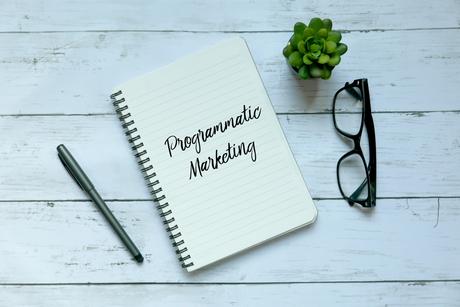
RTB. DMP. DSP. SSP. It might seem like Greek at first, but programmatic marketing and its terminology aren't all that complex. And this strategy can be one of the most efficient and profitable for your marketing budget. If you're not already using programmatic advertising, you're missing out on a more intelligent way to reach your target audience. In fact, over 80% of all digital ad spend in the U.S. is programmatic, and it's expected to increase to $66 billion by next year. From basic definition to tips for success, this post has all the essential programmatic marketing information you need to know.
Programmatic marketing defined
Basically, programmatic marketing is the use of software to buy digital ad space. This strategy uses data to determine which ads to buy and for how much money, often in real time. Programmatic systems continually coordinate to target individuals based on what they are most likely to engage with and at a time they're likely to do just that. Largely automated, programmatic buying does rely on algorithms and technology to buy the advertising. However, even the best technology is futile if your messaging is irrelevant or poorly crafted. With programmatic marketing, the time saved on cumbersome manual bidding opens marketers up for more sophisticated ad campaigns and strategic optimization, which ultimately improves bidding algorithm performance.
The two types of programmatic advertising
Real time bidding (RTB) is the most popular type of programmatic marketing. It involves the purchase of ads through real-time auctions on a per-impression basis. The four necessary components to RTB are the publisher, a supply-side platform, a demand-side platform, and an advertiser. The process for this system takes mere seconds to complete and begins when an internet user clicks on a webpage. The publisher of the page then puts the ad impression up for auction. Finally, the advertiser with the highest bid (automated) wins the display.
This type of marketing is a bit closer to traditional media buying. It is the use of programmatic software to directly buy a guaranteed number of impressions in advance from specific publisher sites. Though programmatic direct is less common than RTB, publishers sometimes reserve their most valuable space for these direct deals with top-tier advertisers. Programmatic direct is also a desirable option for buyers who are planning campaigns that they want to ensure the right placements and prices for in advance.
Some important terms to be familiar with:Data management platform (DMP) - used by marketers, agencies, and publishers to handle and merge data.
Demand-side platform (DSP) - offers advertisers the ability to launch and manage online ad campaigns on an open exchange as well as use DMPs.
Supply-side platform (SSP) - used by publishers to connect their inventory to DSPs and ad networks and sell advertising at the most advantageous rates using RTB.
(Check out Unruly's programmatic glossary of other related terms.)
How it works
Media agencies are the most popular method of buying programmatic advertising. In an Econsultancy survey, 43% of respondents reported using an entirely agency-run programmatic trading model. When choosing a provider, it is important to evaluate the company's technology, expertise, inventory and data. Once a provider is selected, you will supply them information about your campaign and key performance indicators. From this information, an algorithm is created. This algorithm determines where your money is best spent because it uses real-time, first- and third-party data to identify consumers by their behaviors, interests, devices, geography, time of day and even weather. These personal insights allow you to reach a very specific demographic at an ideal time and location, even on an impression-by-impression basis. The programmatic system launches your campaign and monitors your spending for improvement opportunities.
Tips for success
- As with any strategy, set clear and realistic short- and long-term goals.
- Carefully consider the cost you're paying your platform provider, and analyze your programmatic transactions to determine break-even costs.
- Do even more audience research! This means more data point analysis. Learn as much as you can about your target audience from their internet consumption habits. Do this, not only to better retarget customers but also to find similar audiences who could be potential customers. Become an expert on the customer journey and invest your programmatic budget accordingly.
- Explore mobile ad inventory possibilities, as nearly 80% of programmatic ad spend will go to mobile ads this year.
- Evaluate your workflow to determine how to best use the resources you will save with a programmatic approach.
What to watch for
Because programmatic relies on algorithms, advertisers and publishers have limited control. Ads can sometimes appear where you might not want them. To protect your brand image, a blacklist - or even a whitelist - can narrow the field of sites and ensure that ads land in appropriate spaces. Additionally, strengthen your provider contract with specificity to protect your interests. Clarify the stability of tech fees, visibility into purchased media and distribution of impressions, control over your advertising and access to data, even in the instance of a hypothetical supplier switch. You will want to follow up to make sure your purchased impressions were delivered as well. Also, keep in mind that agencies have relationships with publishers, which can create bias toward those publishers when it comes to your advertising. Lastly, it's important to be wary of bot fraud too, which costs digital advertisers billions annually.
You're all set! Armed with basic programmatic marketing understanding, you are ready to set goals and start new campaigns. The days of tedious, reservation-based orders with 40+ steps will just be part of your history as you evolve away from expensive, unreliable practices. Streamline your ad-buying process by embracing the programmatic marketing approach, and the rewards will be obvious, from increased flexibility to expanded publisher access to higher ROI. Ultimately, it will bring you closer to delivering the right message, to the right person, at just the right time.
